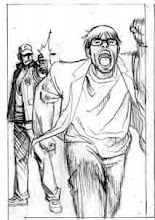Saburau (to serve as attendent)
Bushi (sino-japanese; armed gentry)
Outsiders vs Self-referential
Musashi & Yagyu
Book of 5 Rings & Book of Family Traditions on the Art of War
Written in the peasant's language rather than noble
Lived during the founding era of the third Tent Government. 17th Century to mid 19th Century.
First - 150 years - Ainu - warrior nobles - Kamakura
Second - 1338 - warrior class expands - Ashikaga - Kyoto
Never a fully united Japan until 1868
Warring States - 15th & 16th Century.
Lower class vs Upper class
Civil War led to Third Tent in late 16th Century.
Shogun disarmed peasants/disenfranchised the samurai. Tokugawa period. Tokyo.
Ronin, unemployed samurai, minimal forces in castles
Teachers, physciians, priests, sensei, criminals
Mushashi - masterless samurai dueler & teacher
Yagyu - war veteran and servant of military government
The Book of Five Rings - The Book of Five Spheres
Art of war as pragmatic enterprise
Psychology & physics of lethal assault
Mushashi killed first at 13 last at 29
Strife, mortal combat, then peace unseen in history
Principles:
Keep calm inwardly, clear even in the midst of violent chaos
Not forgetting the possibility of disorder in times of order
Book of Family Traditions on the Art of War
Yagyu, trained by his father, teacher, Martial Arts Teacher to Family of Shoguns. "New Shadow" school.
Published 1632, as he becomes head of secret service
Three scrolls
Killing Sword, Life-Giving Sword, No Sword.
Force to quell disorder/eliminate violence, preparedness to perceive impending problems and forestall them, and capacity to make full use of environment.
Zen Buddhist material. Buddhists tried to enlighten warriors.
